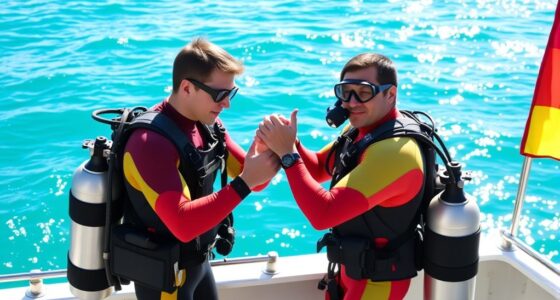When exploring coral reefs, you must adopt responsible diving practices that protect these delicate ecosystems. Familiarize yourself with local guidelines and promote sustainable tourism. Maintain neutral buoyancy and avoid touching corals, ensuring minimal disturbance to marine life. Keep a respectful distance from sensitive species and limit group sizes to reduce impact. Reflect on your experiences post-dive to share conservation awareness. By making thoughtful choices, you contribute to preserving these vibrant underwater habitats for future generations. There’s much more to discover about this essential subject.
Key Takeaways
- Familiarize yourself with local regulations and promote sustainable tourism to minimize environmental impact while exploring coral reefs.
- Maintain neutral buoyancy and practice controlled movements to avoid damaging marine habitats and creatures.
- Keep a respectful distance from sensitive species, allowing them to behave naturally without interference.
- Limit group sizes and reduce noise to enhance the diving experience and lessen disturbance to the ecosystem.
- Reflect on your dive experiences and share insights to raise awareness about the importance of marine conservation.

As you dip beneath the shimmering surface of the ocean, a vibrant world unfolds before you—one filled with an astonishing variety of life. Coral reefs, often referred to as the rainforests of the sea, teem with colorful fish, intricate corals, and stunning marine creatures. While exploring this breathtaking ecosystem, it’s essential to practice responsible diving techniques that contribute to marine conservation. Not only does this guarantee your adventure remains sustainable, but it also helps protect these delicate habitats for future generations.
Before you even enter the water, you should familiarize yourself with the area’s specific guidelines and regulations. Many dive sites focus on sustainable tourism, promoting practices that minimize human impact on the environment. By respecting these rules, you’re actively participating in the preservation of coral reefs. For instance, avoid touching the corals or stirring up sediment, as both actions can damage these fragile organisms and disrupt the surrounding ecosystem. Remember, every interaction matters, and your choices can either harm or protect this underwater paradise.
Familiarize yourself with local guidelines to protect coral reefs and ensure a sustainable diving experience. Every action counts in preserving our underwater paradise.
As you glide through the water, keep your buoyancy in check. Maintaining neutral buoyancy not only enhances your diving experience but also prevents accidental contact with corals and marine life. Use your fins wisely, and avoid kicking up sand or debris that could smother corals. You’ll find that the more you practice these techniques, the more you’ll appreciate the beauty surrounding you without leaving a trace.
When observing marine life, maintain a respectful distance. Many creatures, like sea turtles and manta rays, are sensitive to human presence. By keeping your distance, you allow them to engage in their natural behaviors, contributing to the overall health of the reef. Additionally, consider limiting the number of divers in your group to help minimize disturbances. Smaller groups create less noise and disruption, leading to a more enjoyable experience for everyone involved.
After your dive, reflect on the incredible sights you’ve encountered and the responsibility you hold as a visitor to this fragile ecosystem. Share your experiences with others, encouraging them to practice sustainable tourism as well. By raising awareness of marine conservation and responsible diving practices, you’re playing an essential role in protecting coral reefs. Furthermore, understanding the importance of marine ecosystems can deepen your appreciation for the underwater world.
In the end, exploring the underwater world is about connection and respect. By embracing responsible diving practices, you not only enrich your own experience but also contribute to the preservation of these stunning ecosystems for generations to come.
Frequently Asked Questions
What Equipment Is Essential for Responsible Diving in Coral Reefs?
For responsible diving in coral reefs, you’ll need essential diving gear like a wetsuit, buoyancy control device, and fins. A mask and snorkel are vital for clear underwater vision, while dive computers help you monitor your depth and time. Don’t forget a camera to capture marine life without disturbing it. Make sure you’ve got a reef-safe sunscreen to protect both your skin and the ecosystem. With the right equipment, you can dive responsibly and enjoy the beauty beneath the surface.
How Can I Identify Healthy Coral Versus Damaged Coral?
“Don’t judge a book by its cover.” To identify healthy coral versus damaged coral, look for vibrant colors and robust structures. Healthy coral appears bright and full of life, while damaged coral often shows signs of coral bleaching, turning white and lifeless. Additionally, check for marine debris; if you see trash or harmful materials among the coral, it’s a sign of distress. Healthy reefs thrive, so keep an eye out for these indicators!
Are There Specific Seasons for Visiting Coral Reefs?
Yes, there are specific seasons for visiting coral reefs. The best visiting seasons typically fall during dry months when water clarity is at its peak, often between late spring and early fall. If you want to avoid crowds and save some money, consider off-peak travel times, like late fall or early spring. You’ll enjoy a more peaceful experience while still witnessing the stunning beauty of these underwater ecosystems.
What Are the Main Threats to Coral Reefs Today?
Coral reefs face several threats today, primarily from climate change and pollution. Rising ocean temperatures lead to coral bleaching, while ocean acidification weakens their structures. Additionally, overfishing and habitat destruction further harm these ecosystems. Marine protected areas can help mitigate these issues by conserving biodiversity and allowing reefs to recover. You can play a role in their preservation by supporting sustainable practices and advocating for stronger protections for these essential marine habitats.
How Can I Support Coral Reef Conservation Efforts?
You can be a guardian of the ocean’s jewels! Start by supporting marine protected areas, which shield essential ecosystems. Volunteer for reef restoration projects in your community, helping to restore coral and marine life. Spread awareness about the importance of coral reefs to friends and family, encouraging them to get involved too. Every small action counts, and together, you can create a wave of change that helps preserve these underwater wonders for future generations.
Conclusion
As you plunge into the vibrant underwater world of coral reefs, remember you’re not just a visitor; you’re a guardian of this breathtaking ecosystem. Each dive is a dance with the delicate balance of life, where your every move can echo through the depths. By practicing responsible diving, you help preserve the kaleidoscope of colors and creatures that call these reefs home. So, dive wisely, and let your adventures ripple through time, ensuring future generations can experience this underwater wonder.










